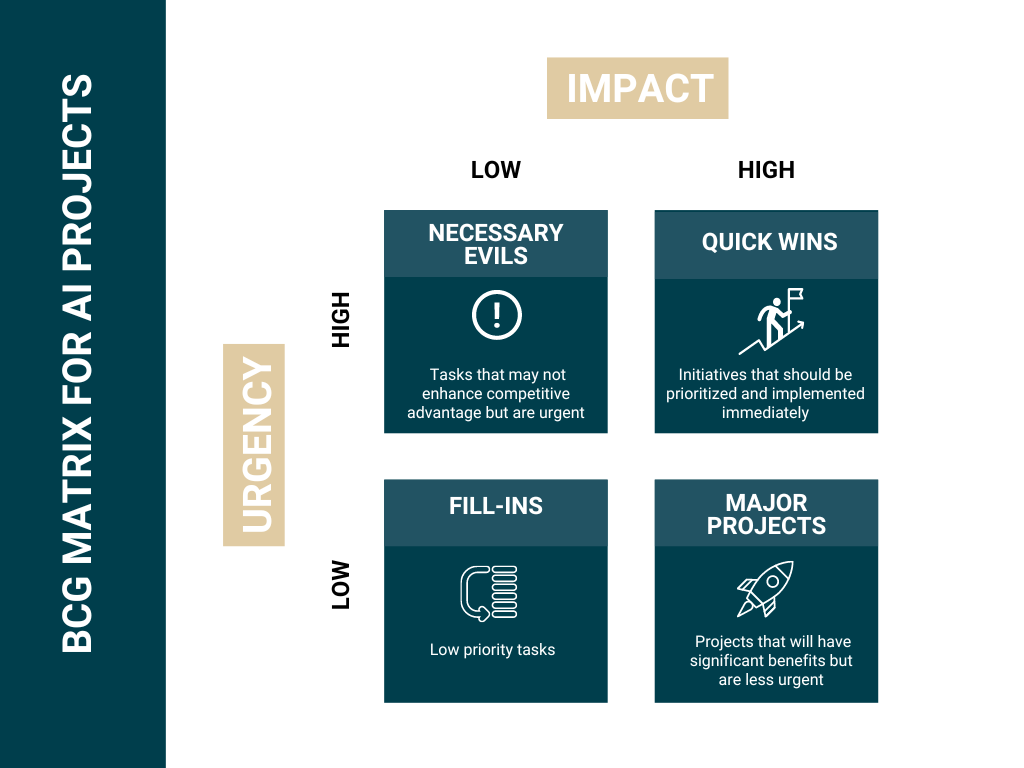Four Fundamental Steps for Developing an AI Roadmap for Your Company
If you were to open your email inbox right now, scroll through your social media feed or tune into your preferred news source, the chances are that “AI” makes more than a dozen headline appearances. As business leaders, we must keep up with the latest AI developments in our sector and evaluate how this volume of information affects our own lives, our employees, and our customers.
Then there is the added challenge of staying ahead of the hype-curve and crafting a sustainable AI strategy for our organizations. One that will defend against competition, avoid disruption, and allocate resources efficiently. The latter is particularly challenging given the rapid rate of development across generative AI in the last five years.
Perhaps like many, you feel that your company should be doing something to leverage AI to prepare for that horizon, but what? We suggest breaking down your thinking into a four-stage strategic process, combining time-honored business tools and research into a clearly communicated roadmap for how AI can add value to your business.
Step #1 Shaping a Strong Strategy
The first building block towards ensuring a comprehensive approach to AI adoption is understanding how it is (or isn’t) consistent with your overall firm strategy. This includes how it impacts competitive positioning, and a clear articulation of your desired outcomes. We suggest you start by dusting off Michael Porter’s ‘Five Forces’ framework and revising your organization’s competitive dynamics, threats, and opportunities.

Do you compete based on cost leadership, differentiation, cost focus or differentiation focus? Reevaluate the latest developments of AI in your sector (if any). Does AI introduce a threat of new entrance, a change in supplier or customer bargaining power or the ability of customers to find substitutes for your product or service? How could your organization’s implementation of AI help you compete against these forces? Using this type of strategy framework will help keep your potential AI investments aligned with your other strategic goals and ensure a comprehensive versus siloed approach.
Step #2 Assessing Organizational Fit
Next, think about the current role of technology in your organization, and how it assists managers, employees and customers or prospects with efficiency and productivity. With the information from the previous step, consider how AI might contribute to (or be inconsistent with) your current competitive strategy, and where you would like to be. For example, in a service industry you may wish to use AI to enhance revenue opportunities, improve research yield or professional productivity.
When looking at AI solutions for these challenges, businesses face a choice: to harness the established giants who are advancing AI, integrating them via APIs; or to create bespoke models for data privacy and tailored solutions. This decision hinges on factors such as operational maturity, resource availability, strategic priorities, and data sensitivities (i.e. risk, compliance or security) for the company.
Step #3 Developing the Implementation Sequence
To decide which of these opportunities to prioritize, we recommend an adaptation of another strategy classic, the Boston Consulting Group’s ‘Priority Matrix’. To apply the tool, take one of your possible AI initiatives, and consider to what degree the initiative will directly or indirectly increase competitive advantage. In other words, how would you rate the organizational impact this initiative would have? You can use a numeric scale or something as simple as High versus Low.

Next, consider, and plot out, where the initiative rates in terms of urgency. Would the impact be considered a ‘quick win’ or would it require a major project plan? Does the initiative drastically shape your competitive advantage or address market rivalry?
Finally, we like to add a third category (indicated on the chart by the size of the bubble) that considers the complexity of implementing the initiative. For example, does it require special hardware, licenses, or technical expertise that your organization does not currently have? How ready is your internal data for the implementation of AI? What role will humans (your customers or employees) play alongside the technology? Does it free them up for more purpose-oriented tasks or transform a role/task entirely?
Having rated each of the AI initiatives for impact, urgency, and complexity, we can illustrate the order in which they should be implemented. One approach is to start with the initiative with the highest impact and urgency and lowest complexity. This will give the highest return on investment, however you define this (which does not have to be monetarily). High complexity, high urgency and low impact ideas may need to be put on the backburner, while high complexity, high urgency and high impact projects need to be started as soon to as possible to allocate resources effectively and track progress.
Step #4 Preparing the Organization for Change
Once you’ve decided on your company’s initial AI strategy and order of priority, we suggest creating a roadmap that key stakeholders can use to easily communicate and understand the shared vision, key milestones, and timeline for adoption. This will help identify risk, gaps, and dependencies upfront rather than facing potential catastrophes later. Three of the biggest preparation hurdles you may face are 1) data availability, privacy, and security, 2) mitigating risk and adhering to compliance requirements in your sector and 3) preparing your team for change.
First, particular care and attention should be paid to data management in all companies. When working with machine learning or natural language processing, great care needs to be taken in obtaining suitable types and amounts of data, ensuring it is clean, complete, and free of noise. Companies should also consider where the data is sourced from, any ethical issues, and storage. Attention should be paid to the time and cost associated with the development of data pipelines, serving as the necessary data for training and prediction.
Once you have identified key stakeholders to address data management, we advise turning your attention to the important regulatory, legal, and compliance bodies that govern your sector, your firm, and/or your geographic areas of operation. Existing privacy laws aren't well-designed to address AI's privacy problems and according to a report published by leading law firm White & Case, ‘there is no comprehensive federal legislation or regulations in the US that regulate the development of AI or specifically prohibit or restrict their use’. However, the US [currently] relies on existing federal laws and guidelines to regulate AI but aims to introduce AI legislation and a federal regulation authority’ Outside of the US the story appears much the same.
The remaining consideration is the impact on your people and culture. To that, there are many opinions on AI; ‘from human roles will be completely eliminated’, to ‘there is no way AI can replace human interaction, insights, and intel’. When it comes to IMAP’s posture and AI strategy roadmap, we are taking a broader, more positive vision, like that of the newly formed EU-U.S. Scientific Cooperation in AI who seem focused on applying AI systems for social development. We hope to provide our employees and partners with best-in-class productivity tools to help them evolve from “production-doers” to “thinker-facilitators”.
At IMAP we believe in the power of human collaboration with technology to achieve results that neither could achieve alone. In this way, we are better able to serve our clients globally.

Olivia Ferris is the Chief Operating Officer of Capstone Partners - IMAP USA where she is responsible for overall firm strategy, corporate development, partnerships, strategic initiatives, and investments. Knowing the firm needed to embrace AI, she enrolled in MIT’s executive education course “Implications of AI on Business Strategy”. She has since developed an AI strategy for Capstone, using the process described above, to innovate, gain efficiencies, and optimize growth.